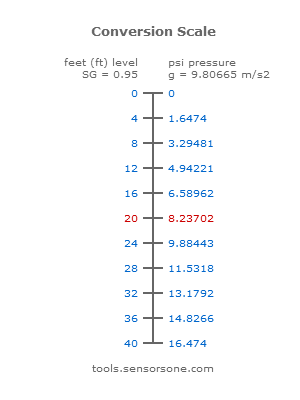Click to reload page with unique web address for bookmarking or sharing current settings
Related Tools
- Hydrostatic pressure to liquid level calculator
- Fluid depth, density, gravity and pressure calculator
- Local gravity calculator
- Pressure units converter
- Length units converter
User Guide
This calculator and conversion scale will convert the height or depth of a fluid in any units to a measurement of hydrostatic head pressure, and display a list of conversion values above and below the entered liquid level.
Formulas
The calculation formulas used for this tool are:
P = L · ρ · g
ρ = ρ0 · SG P = L · ρ0 · SG · g
Symbols
- P = Pressure
- L = Liquid height
- g = local gravity (e.g. standard = 9.80665ms-2)
- ρ = Density of liquid
- ρ0 = Density of fresh water (1000 kgm-3 @4°C)
- SG = Specific gravity of liquid (e.g. fresh water = 1)
Height of Liquid Column
Enter the measured liquid depth to, or the height of fluid from a point at which the hydrostatic pressure is to be calculated.
Specific Gravity (SG)
Enter here the ratio of liquid density compared to the density of fresh water (1000 kg/m3). The default value is set to an SG of 1.00, which corresponds to fresh water at 4 degrees Celsius.
Local Gravity (g)
Enter the acceleration due to gravity for your geographical location in metres per second per second (ms-2). The local gravity is dependent on several factors such as latitude, height above sea-level, local geological density, etc… Refer to your national geological survey data for your location or use this local gravity calculator to determine a close approximation. The default value is set to 9.80665 ms-2 which is standard gravity.
Hydrostatic Pressure
This is the calculated head pressure expected from the entered values for liquid level, specific gravity and local gravity. The calculation determines the difference in pressure between the bottom of the liquid column and the surface of the liquid, therefore it excludes any pressure contribution from air or a gas on the surface.
Applications
- Head pressure
- Water resistance testing
- Hydrohead
Help
Impact of local gravity on hydrostatic pressure measurement
How significant is the variation in local gravity when calculating hydrostatic pressure for liquid level measurement, and when should I use a precise value instead of standard gravity?
For the vast majority of industrial and civil engineering applications, using the standard gravity value of g = 9.80665 m/s2 is perfectly adequate. The variations in Earth’s gravitational field due to latitude and altitude are small enough that their effect on hydrostatic pressure calculations is typically negligible, especially when compared to other sources of measurement uncertainty like fluid density changes with temperature.
To illustrate, the acceleration due to gravity ranges from approximately 9.78 m/s2 at the equator to 9.83 m/s2 at the poles. This represents a maximum variation of only about 0.5%. In a typical tank gauging application, this level of variation results in an error that is often smaller than the accuracy specifications of the pressure sensor itself.
Pressure generated by 40 foot high tank of Diesel
How would I determine the pressure range required to measure a 40′ deep diesel storage tank?
To determine the pressure generated by a 40 feet of Diesel, you will need to know the specific gravity (S.G.). The S.G. of Diesel varies depending on temperature and diesel type, but 0.95 is the maximum often indicated by many resources. Using this calculator a 40 foot column of Diesel would convert to 16.474 psi.
This conversion scale shows the conversion values over the 0 to 40 feet range:

Pressure on bottom of circular tank
What is the formula to calculate liquid pressure on bottom of a circular tank?
The pressure is directly related to the height of fluid and is independent of tank shape, so you would use the formula above.
Tank area & diameter dimensions
In the conversion of liquid level to pressure, why is there no consideration for the area or diameter of the tank?
Liquid level is directly proportional to hydrostatic pressure, so there are no other dimensions that need to be considered when converting liquid level to pressure. Area or diameter do not affect liquid level, but they do affect the liquid contents & volume measurement such as in a horizontal cylinder tank.
